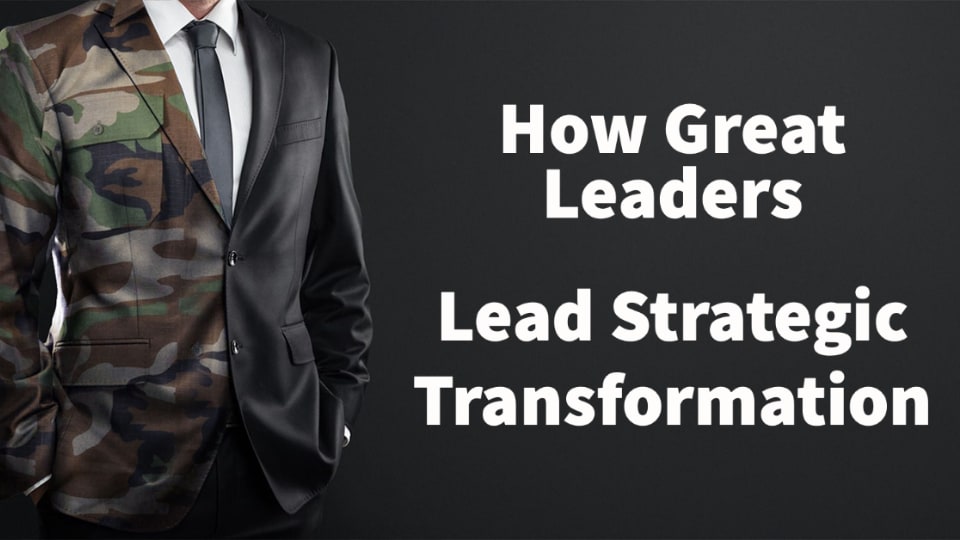Strategic transformation is the journey your organization will take to in its attempt to maintain or achieve a competitive advantage. Average leaders don’t have a system for achieving results. On the contrary, Great leaders follow a system to ensure their team knows where they’re going and how to execute.
If you’re reading this, you are likely: 1) Leading strategic transformation efforts for your organization and 2) Looking to improve your results. If so, let’s go ahead and get what doesn’t work out of the way.
The easy but overused methods of managing strategic transformation through word processing templates and spreadsheets consistently fail leaders and their teams. These methods are not scalable, lack governance, and fail to provide meaningful insight into whether strategies are working. If you or your team have been utilizing these tools and not getting the desired results, you’ll want to ensure you know the system great leaders use.
A recent friend’s post referenced Ken Blanchard’s book titled The Secret: What Great Leaders know and do. If you haven’t read this book, I recommend adding it to your list. When you do, you take away the five strategic ways great leaders serve:
- Great Leaders See and Shape the Future
- Great Leaders Engage and Develop Others
- Great Leaders Value Results and Relationships
- Great Leaders Embody Organizational Values
- Great Leaders Continuously Reinvent
As you reflect on these five strategic ways great leaders serve, consider serving your organization through strategic transformation initiatives. The stakes get raised, pressure mounts, you need a culture of ownership, and you can’t afford to fail. You need a better system to manage your strategic transformation efforts.
Let’s take Ken Blanchard’s leadership principles and view them specifically through the lens of a Great Leader Leading Strategic Transformation.
Great Leaders See and Shape the Future
There is not a more quintessential starting point for strategic transformation. A leader must be able to SEE and SHAPE the future to be successful. These two words have such depth of meaning. To see strategic transformation means a leader must be able to: 1) Be the visionary or 2) Participate in creating the vision. In large complex organizations, such as the Department of Defense (DoD), the vision for strategic transformation is typically set at a macro level. As a leader in an agency that falls under the DoD, you’re charged with developing your supporting plan for strategic transformation. As you can imagine, the number of supporting plans, and micro-strategies, can expand exponentially. Nevertheless, all sub-organizations must maintain alignment with the original strategy of the DoD.
For example, let’s say you are with the Department of the Air Force (DAF). You’d tie your strategic transformation initiatives to the DoD and then cast your vision. Further, leaders within your agency will need to understand your strategic transformation priorities and develop their own. With a department the size of DAF, this process could continue three and four times, each with individual strategic transformation priorities that tie back to the DoD’s vision.
To add to the complexity, each leader will likely break down their strategy by developing Lines of Effort (LOE). Each LOE will have strategic objectives, and each owner of a strategic objective should develop a strategic transformation implementation roadmap.
Have I painted the complexity enough?
Now I’ll ask the questions. If you are the leader of the DAF, how do you SEE what your stakeholder(s) and stakeholder teams and teams of teams have created?
You can’t because the tools used today do not allow for visibility into strategic transformation.
How do you shape what you can’t see?
You can’t, so you rely on strategy briefings. A PowerPoint presentation is not strategic communication; it is a highly manual, outdated update with no visibility into if your team’s strategies are working.
To be a great leader in strategic transformation efforts, you must be able to see and shape. Seeing means seeing the battlefield, the entire landscape, and quickly assessing where you’re needed. That is, in part, how you shape strategy.
Great Leaders Engage and Develop Others
Strategic transformation efforts take an all-in approach. It takes engagement at an appropriate level. It takes knowing when you’re needed and what your stakeholders and stakeholder teams need. “Engagement” may highlight the problem with how strategic transformation is executed more than any.
I’ll continue with the obvious questions. If great leaders engage and develop, how do you know when to engage, and how do you know how to develop your team best?
- Do you rely on hearsay or word of mouth?
- Do you have the ability to drill down rapidly into the source of the problem through a digital dashboard?
- How do your stakeholders strategically communicate your transformation efforts?
- How do their teams assess their operational challenges? How do stakeholder teams and teams of teams assess required resources? How do what your stakeholder(s) and stakeholder teams need to be successful get communicated back to you?
My guess is that your answer to the questions above is “not great” and “very manually.” This problem makes strategic transformation efforts extremely challenging. You know you need to engage and develop your team, but if you don’t know what’s required, how can you help? The over-reliance on word processing and Excel does not provide you with the ability to engage. Your teams will continue to struggle to ask for what they need, and while they do, you are left frustrated, not knowing how to help.
Great Leaders Value Results and Relationships
Nothing is more unfair than expecting results and not providing your team with the tools to succeed. It undermines both results and relationships. Let’s take these two critical leadership topics one at a time.
Results. Let’s be honest, if you don’t get results, you’re gone, or you get moved sideways to save face. So you must get results.
Your team must value your desired results and believe you value their efforts. They must feel supported. To feel supported, your team must understand what you want and have a mechanism to assess what they’ll need to achieve the desired results. Once evaluated, your team must have a systematic and efficient way to ask for required resources. Required resources represent the resources (internal or external) that your team needs to achieve the desired results.
Not to be too repetitive, but I’ll move back to my questioning. What system do you have in place for your team to assess what they’ll need to achieve the results you need? How does your team know what results you value? How will you engage in a way so that your team knows you’re informed of their challenges and have a situational awareness that demonstrates you care?
“While work cultures are unique to every organization, the foundation of what enables a culture to thrive is the extent to which employees are empowered to be engaged, feel valued, and be heard” ~HBR
“Valuing results” can’t be just about your results as a leader. Instead, it’s about developing a culture of results. A culture of results depends on a clear understanding of the vision and a clear line of communication of what’s needed to be successful. If you don’t have a way to understand what your team needs to be successful in your strategic transformation efforts, your team won’t feel valued. It’s not a chicken or egg situation. Once your employees feel valued, they’ll appreciate the results you’re looking to achieve and buy into your culture. When your team believes in the mission AND understands the work they contribute is meaningful, you build strong team relationships.
Great Leaders Embody Organizational Values
“A company’s core values are a set of guiding principles put in place by its founding members as to what they believe all their workers should follow regularly. These fundamental beliefs dictate policies drawn up regarding all aspects of the workplace.” ~Forbes
In practice, I’ve seen many organizations make no association between values and results. Every leader faces the pressure to deliver results. That is why they’re in a leadership position. The problems begin when leaders focus only on results and dismiss organizational values. So let’s break this down.
If you are to look across your organization, who would you say best represents what the organization stands for? Who is most passionate about the mission? Who was explicitly recruited based on how their values aligned with your organizational values?
These are tomorrow’s leaders. These are who you want to lead your strategic transformation efforts. These individuals make up the team that will get results because they’re invested and committed to a larger mission. To make the most of your strategy and those who will implement it, give them the tools necessary to succeed.
Great Leaders Continuously Reinvent
The days of developing a strategy every three to five years are gone. Your strategy needs to be constantly in motion. This means continually developing strategy, architecting governance, aligning stakeholders, creating a baseline and key results, implementing micro-strategies, monitoring effectiveness, and adapting where necessary. Most organizations do not have a system for operating their strategy. As a result, stakeholder teams attempt to manage complexity with traditional Word and Excel tools. These tools are simply inadequate for larger organizations.
“I know my team is working hard and implementing what we discussed, but we just don’t have visibility into whether our strategies are working.” ~Retired DAF General
How about you? Do you have a uniform way for your team to execute strategy? Do your stakeholder teams have a consistent way to assess what they need? Do your stakeholder teams develop a baseline for each key result that will drive the areas of strategy they own? Do you know if the strategies your team is implementing are working???
If not, continuously reinventing is likely a slogan your team is already tired of hearing.
If you have read this far, it means you care, and you’re searching for a way to improve your organizational results. If you don’t have a system, you’re not being fair to yourself or your team. If you’d like, I’ll gladly help you think through how to transform your organization better, so your teams stay engaged and committed.




